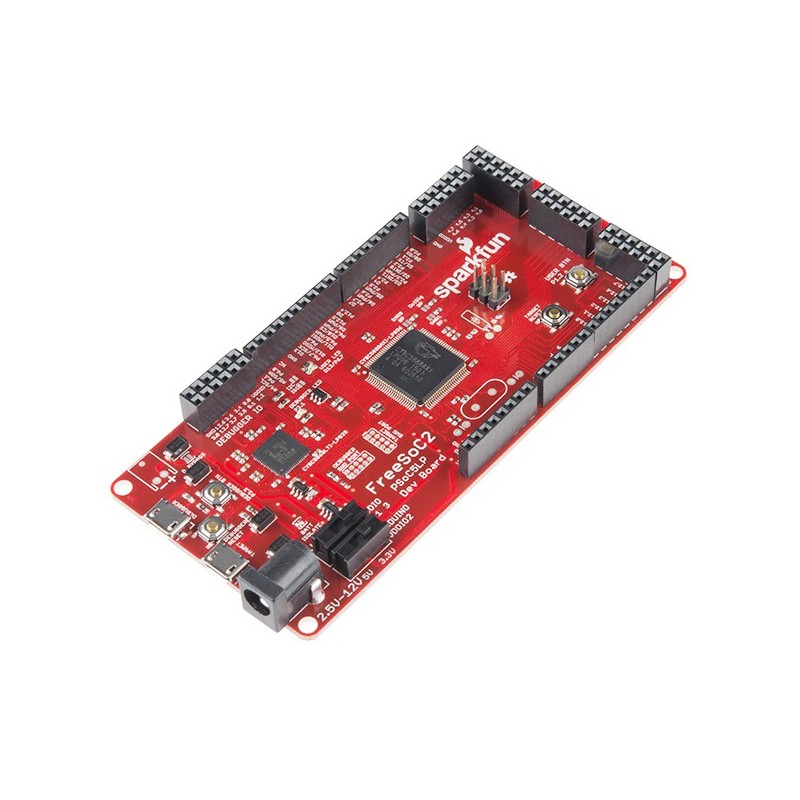- Out-of-Stock






FreeSoC2 board has two processors on-board: a CY8C5868LTI-LP039 and a CY8C5888AXI-LP096. The former serves as a debugger/programmer for the latter, which is the target upon which your application code will be installed. Both parts contain a Cortex-M3 processor core, 256kB of flash memory, 64kB of SRAM, and 2kB of EEPROM. DEV-13229
FreeSoC2 Development Board - PSoC5LP
Description:
This is the FreeSoC2 Development Board, SparkFun’s take on the PSoC5LP ARM Cortex. The PSoC (Programmable System on a Chip) brings together features of the programmable devices and microcontroller-type systems on chips into one package. By placing a programmable fabric between the peripherals and the pins, the FreeSoC2 allows any function to be routed to any pin! Moreover, the on-board PSoC includes a number of programmable blocks which allow the user to define arbitrary digital and analog circuits for their specific application.
SparkFun’s FreeSoC2 board has two processors on-board: a CY8C5868LTI-LP039 and a CY8C5888AXI-LP096. The former serves as a debugger/programmer for the latter, which is the target upon which your application code will be installed. Both parts contain a Cortex-M3 processor core, 256kB of flash memory, 64kB of SRAM, and 2kB of EEPROM. The only significant difference between the two are package size and clock speed. The target is in a TQFP-100 package which provides 72 IO pins versus the debugger’s QFN-68 package and 48 IO pins, and the target can operate at 80MHz versus the debugger’s 67MHz limit. Additionally, the FreeSoC2 can support 5V and 3.3V IO voltages.
With a simple upload of new firmware, the Arduino core has been ported to the PSoC5LP, so you can write code for the board in the standard Arduino IDE. The board duplicates the functionality of an Arduino Uno R3’s various hardware peripherals on the pins, so many examples, libraries, and shields will work on this board. However, to get the most out of the device, you will need to use the PSoC Creator IDE (which is free of charge with no code limits from Cypress Semiconductor). Please keep in mind that the PSoC Creator software is Windows-only at this time.
Note: The FreeSoC2 Develpment Board is a collaboration with Jon Moeller. A portion of each sales goes back to him for product support and continued development.
Features:
Documents:
Manufacturer BTC Korporacja sp. z o. o. Lwowska 5 05-120 Legionowo Poland sprzedaz@kamami.pl 22 767 36 20
Responsible person BTC Korporacja sp. z o. o. Lwowska 5 05-120 Legionowo Poland sprzedaz@kamami.pl 22 767 36 20
Camera module with USB interface with 2MP resolution. Camera with Sony CMOS IMX323 sensor, the module is equipped with two microphones. ArduCAM UB0212
No product available!
COM-11964 Button a white economy grade 100mm diameter (outside diameter) dome illuminated push button comes with an LED, securing nut and a long life horizontal microswitch.
No product available!
No product available!
No product available!
No product available!
No product available!
group work
No product available!
ROSA3D filament made of thermoplastic polyurethane. 0.5 kg of filament with a diameter of 1.75 mm is wound on the spool. ROSA3D ROSA-Flex 96A Green
No product available!
Expansion board with LCD TFT 2.2" display for STM32 Nucleo kits. It can work with the latest version of the TouchGFX 4.15.0 environment. STMicroelectronics X-NUCLEO-GFX01M1
No product available!
ROSA3D filament made of high-quality PLA granules. 0.8 kg of filament with a diameter of 1.75 mm is wound on the spool. ROSA3D PLA Multicolor Silk Moon
No product available!
Pololu RC Servo Multiplexer 4 Channel (assembled)
No product available!
MKII version AVR Mini with microUSB connector is the equivalent of a more extensive programmer MKII AVR PRO and is fully compatible with AVRISP-MKII. It can be used to program microcontrollers from the AVR family: ATtiny, ATmega and ATxmega. It is equipped with two ISP / PDI / TPI 2 x 3 pin connectors
No product available!
No product available!
No product available!
No product available!
No product available!

FreeSoC2 board has two processors on-board: a CY8C5868LTI-LP039 and a CY8C5888AXI-LP096. The former serves as a debugger/programmer for the latter, which is the target upon which your application code will be installed. Both parts contain a Cortex-M3 processor core, 256kB of flash memory, 64kB of SRAM, and 2kB of EEPROM. DEV-13229
